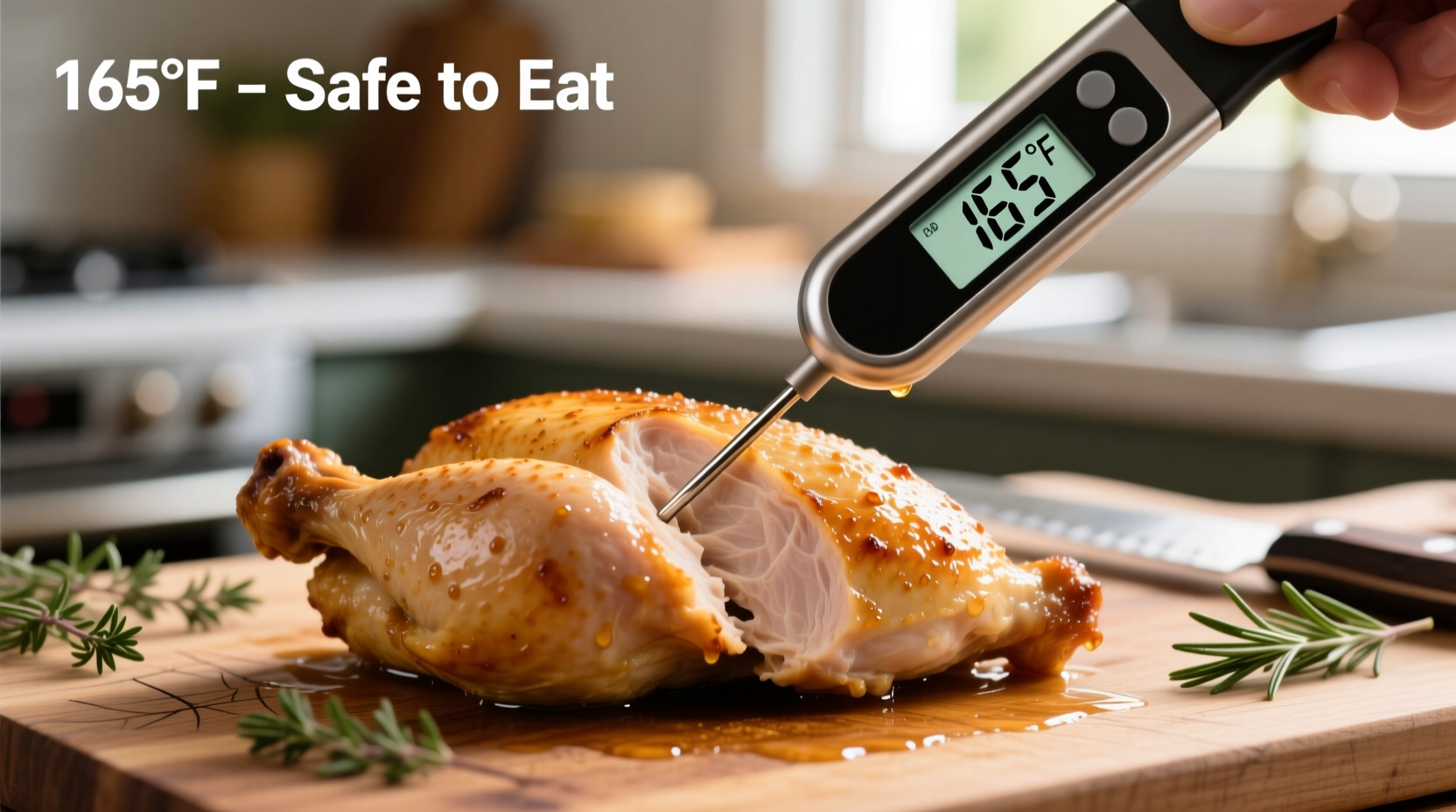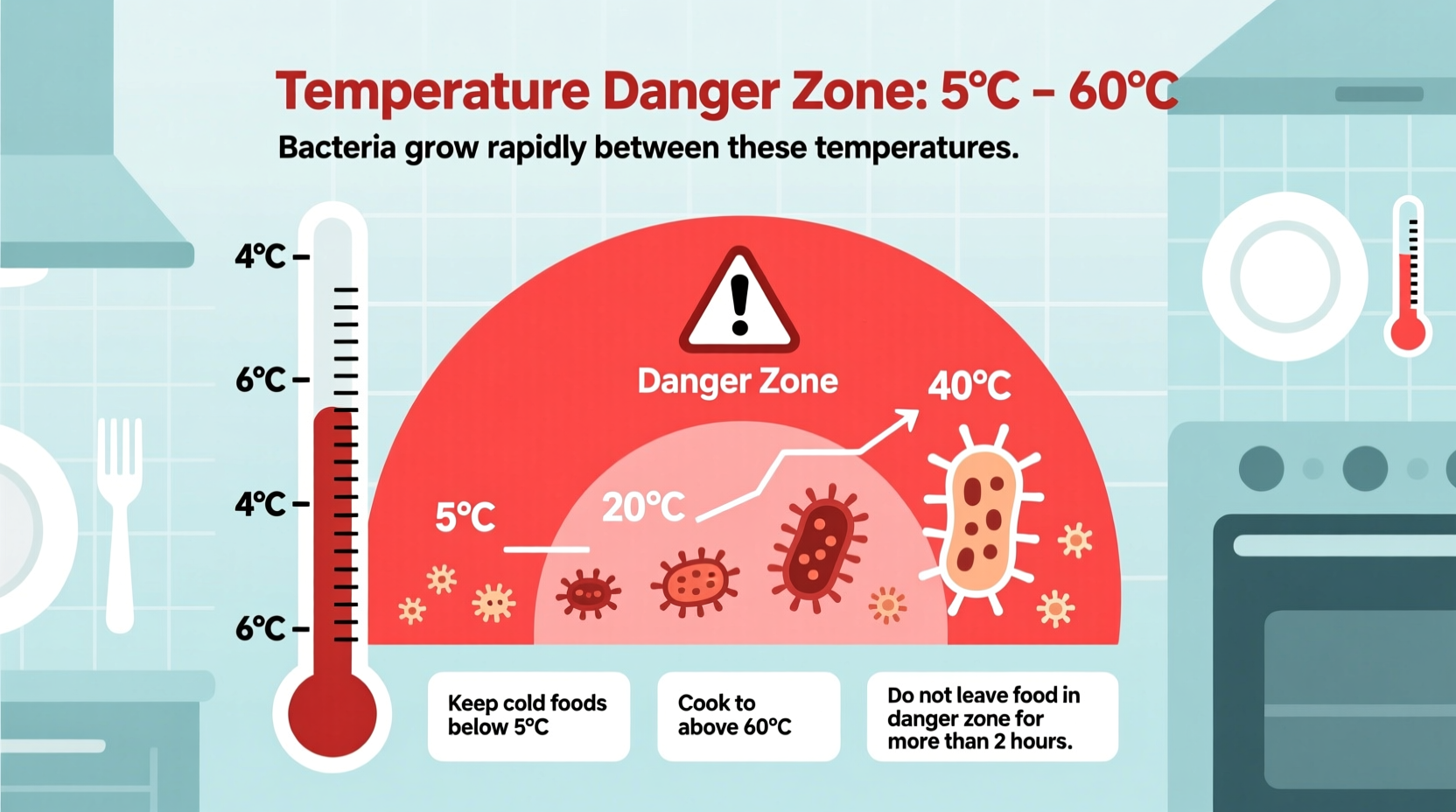Understanding the temperature danger zone isn't just kitchen trivia—it's your first line of defense against food poisoning. Each year, 48 million Americans get sick from foodborne illnesses, resulting in 128,000 hospitalizations and 3,000 deaths according to the CDC. The good news? Most of these cases are preventable when you know how to navigate the danger zone properly.
Why Bacteria Thrive in the Danger Zone
When food sits between 40°F and 140°F, conditions become perfect for bacterial growth. This temperature range provides the ideal environment where pathogens like Salmonella, E. coli, and Listeria multiply exponentially. The USDA Food Safety and Inspection Service explains that bacteria growth follows a predictable pattern:
- At 40°F-70°F (4°C-21°C): Slow growth begins
- At 70°F-125°F (21°C-52°C): Rapid multiplication (most dangerous range)
- At 125°F-140°F (52°C-60°C): Slowing growth as temperatures approach killing point
The critical factor is time. The FDA Food Code establishes the 2-hour rule: perishable foods shouldn't remain in the danger zone for more than two hours. When outdoor temperatures exceed 90°F (32°C), this window shrinks to just one hour. This isn't arbitrary—it's based on bacterial growth models showing how quickly pathogens reach dangerous levels.
Temperature Danger Zone Evolution: A Brief Timeline
Food safety temperature guidelines haven't always been standardized. Understanding their evolution helps appreciate why current standards matter:
- 1930s-1950s: Early food safety research identified temperature as a factor in food spoilage, but precise danger zones weren't established
- 1963: First FDA Food Code introduced basic temperature guidelines
- 1993: USDA officially defined the 40°F-140°F danger zone following E. coli outbreak investigations
- 2013: FDA Food Code updated to include the 135°F threshold for hot holding (previously 140°F)
- Present: Current standards balance scientific understanding with practical kitchen applications
Your Complete Temperature Safety Reference Guide
Knowing the danger zone is just the starting point. You need precise temperature targets for different food handling scenarios. This reference table shows critical temperatures you should memorize:
| Food Handling Scenario | Critical Temperature | Time Limit |
|---|---|---|
| Temperature Danger Zone | 40°F-140°F (4°C-60°C) | Max 2 hours |
| Refrigerator Storage | Below 40°F (4°C) | Varies by food type |
| Freezer Storage | 0°F (-18°C) | Long-term preservation |
| Hot Holding | 135°F+ (57°C+) | Max 4 hours |
| Poultry Cooking | 165°F (74°C) | Instant |
| Ground Meats | 160°F (71°C) | Instant |
| Fresh Meats (steaks, roasts) | 145°F (63°C) + 3 min rest | Instant |
Real-World Danger Zone Scenarios and Solutions
Understanding theoretical temperature ranges is different from applying them in daily life. Let's examine common situations where the danger zone catches people off guard:
Picnics and Outdoor Events
When temperatures exceed 90°F (32°C), the danger zone clock starts ticking faster. Pack perishable foods in insulated containers with ice packs, and use shallow containers to help food cool faster. The USDA recommends dividing large portions of food like casseroles into smaller containers for quicker cooling.
Leftover Management
Many people make the mistake of leaving cooked food out to cool before refrigerating. The FDA advises dividing large quantities into smaller portions and refrigerating within two hours (one hour if room temperature exceeds 90°F). Your refrigerator can handle the heat load from warm food better than bacteria can handle the cold.
Power Outages
During power outages, keep refrigerator and freezer doors closed. A full freezer keeps food safe for about 48 hours (24 hours if half full), while a refrigerator maintains safe temperatures for about 4 hours. The USDA provides specific guidelines for determining which foods remain safe after power outages.
Special Considerations: When Standard Guidelines Need Adjustment
Certain situations require modified temperature approaches. These context boundaries help you adapt standard guidelines to specific circumstances:
- High-altitude cooking: At elevations above 3,000 feet, water boils at lower temperatures, requiring longer cooking times to reach safe internal temperatures
- Vacuum-sealed cooking (sous vide): Requires precise temperature control as food spends extended time in the danger zone during the heating phase
- Commercial kitchens: Must follow stricter time-temperature controls with documented monitoring procedures
- Vulnerable populations: When serving elderly, young children, pregnant women, or immunocompromised individuals, consider using lower thresholds for the danger zone (above 35°F/2°C)

Practical Tools for Danger Zone Prevention
Knowledge alone won't keep your food safe—you need the right tools and habits:
- Invest in quality thermometers: Use separate thermometers for your refrigerator/freezer and for checking food temperatures. Digital instant-read thermometers provide the most accurate results.
- Follow the two-hour rule religiously: Set timers when serving food buffet-style to ensure prompt refrigeration.
- Practice proper cooling techniques: Use ice wands for large liquid quantities, and divide solid foods into shallow containers.
- Calibrate regularly: Test thermometer accuracy annually by checking ice water (should read 32°F/0°C) and boiling water (adjusting for altitude).
Remember that visual cues like color or texture aren't reliable indicators of food safety. The only way to know if food has reached a safe temperature is with a properly calibrated food thermometer. This simple tool prevents more foodborne illnesses than any other single practice.
Common Misconceptions About the Temperature Danger Zone
Several persistent myths put people at risk. Let's clarify the facts:
- Myth: "If it smells okay, it's safe to eat."
- Fact: Harmful bacteria like Staphylococcus aureus and Bacillus cereus can produce toxins without changing food's appearance, smell, or taste.
- Myth: "Refrigeration stops bacteria growth completely."
- Fact: Some pathogens like Listeria monocytogenes can grow at refrigerator temperatures, though much more slowly.
- Myth: "Leftovers are safe for a week."
- Fact: Most leftovers should be consumed within 3-4 days, even when properly refrigerated, as some bacteria produce toxins over time.
Essential Food Safety Resources
Stay updated with the latest food safety guidelines through these authoritative sources:
- USDA Food Safety and Inspection Service: https://www.fsis.usda.gov/food-safety
- FDA Food Code 2022: https://www.fda.gov/food/fda-food-code/food-code-2022
- CDC Food Safety Information: https://www.cdc.gov/foodsafety/index.html
- FoodKeeper App: USDA's mobile app for food storage guidance
Frequently Asked Questions
Can food become unsafe in less than 2 hours in the danger zone?
Yes, when ambient temperatures exceed 90°F (32°C), food enters the danger zone more rapidly. In these conditions, perishable foods should not remain unrefrigerated for more than one hour. High-moisture foods like meats, dairy, and cooked vegetables are particularly vulnerable to rapid bacterial growth.
Does freezing food kill bacteria in the danger zone?
Freezing doesn't kill bacteria—it merely puts them in a dormant state. When frozen food thaws and enters the temperature danger zone (40°F-140°F), any bacteria present will begin multiplying again. This is why proper thawing methods (in the refrigerator, under cold running water, or in the microwave) are crucial for food safety.
How can I tell if food has been in the danger zone too long?
You often can't tell by appearance, smell, or taste. The only reliable method is using a food thermometer to check temperatures throughout storage and preparation. If you're unsure whether food has been in the danger zone too long, follow the food safety rule: "When in doubt, throw it out." Consuming questionable food isn't worth the risk of foodborne illness.
Do all foods have the same danger zone temperature range?
The standard danger zone (40°F-140°F) applies to most perishable foods, but certain items have specific considerations. High-acid foods like tomatoes and citrus have a slightly higher threshold for bacterial growth, while vacuum-sealed or modified atmosphere packaged foods may have different safety parameters. However, for general food safety purposes, the 40°F-140°F range remains the universal standard to follow.
Can cooking food that was in the danger zone make it safe again?
Not always. While proper cooking can kill bacteria, some bacteria produce heat-stable toxins that aren't destroyed by cooking. For example, Staphylococcus aureus produces a toxin that remains dangerous even after cooking. This is why time-temperature control is critical—preventing bacterial growth in the first place is safer than trying to eliminate bacteria and their toxins after they've multiplied.











 浙公网安备
33010002000092号
浙公网安备
33010002000092号 浙B2-20120091-4
浙B2-20120091-4